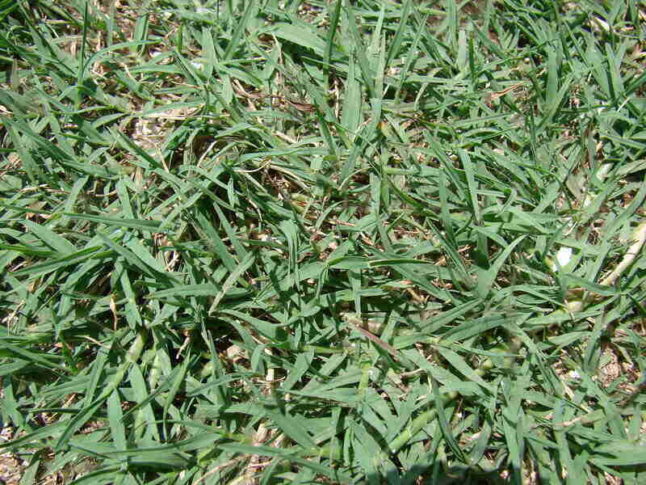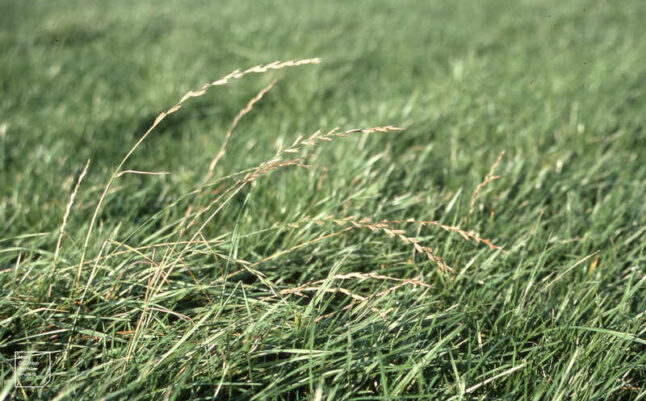
Mid-April through May is the best time to plant Bermuda and other summer grasses in Arizona. Early to mid-October is when you should consider seeding winter grasses. But it’s not enough to know when to plant grass in Arizona. You also need some insight into what kind to plant and how to do it for excellent results.
We’re discussing all of it in this article, with all the practical details you need for a successful lawn in the Grand Canyon State.
Two Growing Seasons For Arizona Lawns
Arizona’s climate allows both summer and winter grasses to thrive across its territory, with two different growing seasons. Learn how to care for both grass types in our guide to growing grass in Arizona.
Summer Grasses

Photo Credit: Forest and Kim Starr / Flickr / CC BY 2.0
Summer grasses, aka warm-season grasses, start to green up in late spring and early summer. This is the best time to seed or install sod, plugs, or sprigs for these grasses. Warm-season grasses love the summer heat and intense sunlight, covering lawns in a vibrant, dense mat until late fall. The most popular in Arizona is Bermudagrass, but you can also grow:
- St. Augustinegrass
- Buffalograss
- Blue Grama grass
- Zoysiagrass
- Bahiagrass
Most summer grasses thrive in the low southern deserts around Phoenix, Casa Grande, Yuma, and Tucson. To choose the best grass for your Arizona lawn, consider soil pH, drought tolerance, and maintenance level.
Cold is summer grass’s weak point. By the end of October, most summer turf varieties go dormant. When temperatures go below 75°F, they stop growing and turn a brownish color.
Winter Grasses

Photo Credit: Dr Mary Gillham Archive Project / Flickr / CC BY 2.0
On the other hand, winter grasses, aka cool-season grasses, love the cool Arizona winters and its northern mountainous climate. They start growing in late fall and stay green and tall until late spring when the sun becomes too hot for them. Among the cool-season grasses you can grow in the Apache State are:
- Perennial ryegrass
- Annual ryegrass
- Tall fescue
- Kentucky bluegrass
Homeowners in the low desert area overseed warm-season turf with winter grasses in fall to keep their lawn green all year round. Overseeding limits foot traffic damage and is a practical weed control measure during winter dormancy.
Next, we’ll cover how and when to plant your summer and winter grasses to get an amazing, thick turfgrass from October to May and back again.
When To Plant Bermudagrass in Arizona
Bermuda has excellent drought, heat, and traffic tolerance and is often considered the best grass for Arizona’s climate. It is best planted in late spring to early summer.
Plant grass seeds mid to late April, when soil temperatures are over 70°F (warm enough to promote seed germination). Bermuda seed takes about one month to establish. If you plant it in April, it has enough time to develop a robust root system before summer. You’ll have a hardy, drought-tolerant lawn by June when high temperatures hit the ground.
If you’re installing sod, the best time is early to mid-May. It’s when air temperatures help the new lawn grow and develop healthy, deep roots. Sod is already grown grass and needs 2 to 3 weeks to establish.
When and How Much to Water a New Bermuda Lawn
Summer lawn care in Arizona involves a lot of irrigation, especially if you need to sustain new grass.
When and How to Water a Seeded Lawn
Keep the soil moist after spreading the grass seed to ensure the best turnover. Start the sprinkler system 4 to 5 times daily until germination and irrigate in short sessions of 5 to 10 minutes.
After the grass gets about one inch tall, reduce watering to 2 to 3 times a day for about two weeks. Then, water once a day until the grass is fully established. An established lawn in Arizona needs water every three days.
When and How to Water Installed Sod
Water newly planted Bermuda sod 4 to 5 times daily, for 5 to 10 minutes, in the first two weeks. Reduce to one time a day for the following week, extending the sessions to 15 – 20 minutes.
The root system establishes in three weeks, and you can start watering 2 or 3 times a week.
Best Month to Overseed With Ryegrass in Arizona
The ideal time to plant winter grass in Arizona is early to mid-October. When you seed ryegrass too early, all the extra water added for germination forces Bermuda out of its dormancy. If you seed it too late, seedlings are vulnerable to low temperatures and grow thinner and weaker.
Before you overseed with ryegrass, you need to prepare the lawn:
- Stop fertilizing a month before. If you plan to overseed in mid-October, stop spreading fertilizer in mid-September.
- Increase mowing height by 30 to 40% two weeks before overseeding.
- Set the irrigation system to water about 30% less two weeks before spreading the rye seeds.
Use 12 to 15 pounds of seeds per 1000 square feet. If there are bare spots, you’ll need more. Arizona nurseries sell two types of ryegrass: annual rye and perennial rye. Annual ryegrass grows light green, less uniform, and dies faster in the spring. Perennial ryegrass costs more but has a darker green color and a lush look most homeowners prefer.
To get a beautiful lawn with either type of ryegrass seeds:
- Use a seed or fertilizer spreader to distribute the seeds uniformly all over the lawn.
- Spread a starter fertilizer and a layer of mulch to protect the seeds.
- Water the lawn 3 or 4 times daily to moisten the soil and help seeds germinate. Avoid overwatering. It exposes the sprouts to diseases and makes the grass more vulnerable to cold weather.
When and How to Transition from Ryegrass to Bermudagrass
Bermudagrass sprouts slowly in early spring, but the active growth period begins in late May or early June when the weather warms up. Ideally, the ryegrass will die off before Bermuda’s dormancy period ends.
But with the new rye cultivars and weather fluctuations, it doesn’t always work this way. You can control the transition and make it smoother. Here’s how:
- Stop fertilizing the winter grass in early February.
- Slowly reduce the height of the mower blades to gradually take the dying ryegrass to the level of the new Bermuda sprouts.
It’s not necessary to scalp the lawn. Thin it enough to expose the soil to the warmth of the sun. The warmth will weaken the ryegrass, and Bermuda will use it to grow faster.
FAQ About When to Plant Grass in Arizona
The best time to overseed a Phoenix lawn is when the nighttime temperatures fall below 60°F. This usually happens in October when warm-season grasses go dormant.
The best time of the year to plant summer grass in Arizona’s climate is April or May. It depends on your location and the local temperatures.
Yes. Many homeowners overseed with ryegrass to keep a green lawn during the winter. Ryegrass is a cool-season grass that thrives in cold weather. It dies in late spring or early summer, leaving the yard free for the summer grass (typically Bermuda).
Just like with turfgrass, it can be hard to keep plants alive and thriving through all of Arizona’s seasons, especially summer. For plants that can survive year-round in your landscape, see our list of the best plants for Arizona heat.
Plant Your Dream Arizona Lawn Today!
Overseeding Bermuda with ryegrass for a green lawn year-round is common knowledge in Arizona. But keeping both types of grass happy and making the transition smooth is an expert’s job. Find a lawn care company near you and get the best turf for every season. Whether you live in Mesa, Scottsdale, Glendale, or Phoenix, LawnStarter can connect you with a diligent pro nearby ready to lend a hand.
Main Image Credit: Shutterstock





